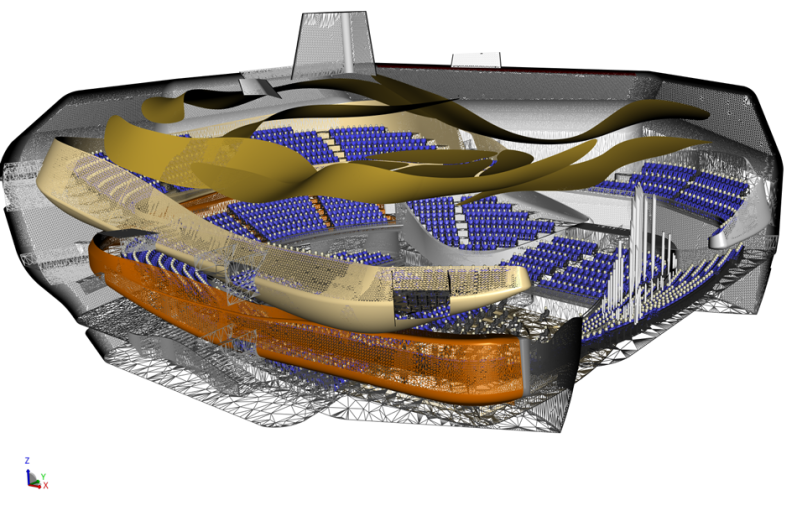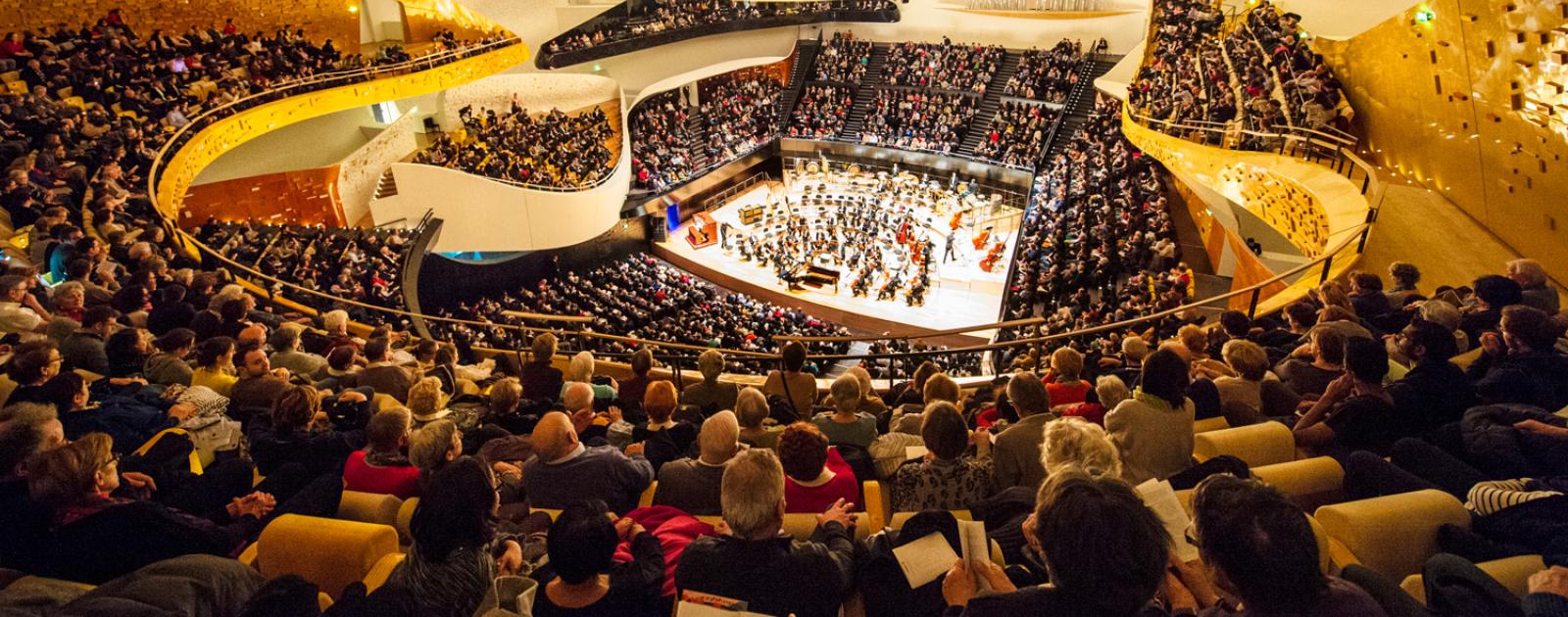Background to the collaboration between the Philharmonie de Paris and Dassault Systèmes
From the start of the COVID-19 pandemic, the teams at Dassault Systèmes were involved in various airflow and particle dispersal simulation projects. Notably, their services were sought for the construction of the Wuhan field hospital, to optimise the position of ventilation systems in patient rooms and limit the dispersal of contaminated particles in the corridors. They are also working on a fundamental research project with AP-HP (a university hospital serving Greater Paris).
Conducted in close collaboration with doctors, these projects aim to help identify the risks of airborne transmission, and to determine simple solutions to reduce these risks.
The Philharmonie de Paris wanted to draw on this expertise in order to prepare the safest possible conditions for the return of spectators and orchestras to the Pierre Boulez Symphonic Hall.
3D modelling of the Pierre Boulez Symphonic hall and the simulation process
The Pierre Boulez Symphonic Hall at the Philharmonie de Paris is equipped with a truly unique ventilation system: each seat has its own individual system, which allows not only excellent distribution of new airflow throughout the hall, but also remarkably quiet ventilation.
 — Modélisation 3D de la Grande salle Pierre Boulez
-
© Dassault Systèmes
— Modélisation 3D de la Grande salle Pierre Boulez
-
© Dassault Systèmes
The teams at Dassault Systèmes reconstructed a highly accurate 3D model of the hall, assuming it is full at maximum capacity. They were able to base this modelling on high-precision data provided by the building’s technical personnel.
The aim of this study is to understand how air moves within the hall, using simulation, in order to assess the effectiveness of the public health measures implemented by the Philharmonie de Paris and, if necessary, to propose other measures.
Study of the movement of air in the hall
Due to the individual ventilation system located beneath each seat, the movement of air in the Pierre Boulez Symphonic Hall is unique: the air mainly flows from the top of the hall downwards (from the second balcony towards the parterre) in a single direction with very little lateral movement. The air flows the same way spectators face, and thus against their backs. All of the airflows converge just in front of the stage, where they rise naturally towards the extraction zones located in the ceiling.
The hall’s dimensions and its particular architecture and airflows liken it to an open and unconfined space. It is, for example, highly improbable that the air from one balcony could reach the balcony opposite. Moreover, the hall’s air delivery speeds are very low (less than 1 km/hr), which limits the dispersal of air and, therefore, particles.
The orchestra is also located in an area where the airflow is controlled and unidirectional (arriving against the musicians’ backs).
Assessment of the effectiveness of the public health measures
The airflow simulation reveals two main areas to assess for reducing particle dispersal risks:
- the effectiveness of using face masks;
- the effect of reducing the ventilation regime.
Effectiveness of using face masks
Multiple scenarios were simulated to verify whether the use of face masks protects both the audience and the orchestra. The teams at Dassault Systèmes considered three case scenarios:
- A contaminated person coughing without a face mask;
- A contaminated person coughing with a surgical mask;
- A contaminated person coughing with a mask fitted to the face (no leakage on the sides).
The animations above illustrate the concentration of particles emitted when a contaminated person coughs. Without a mask, the particles quickly spread towards the back of the spectator in the row ahead. However, as the airflows are firmly oriented, they appear not to come in much contact with the spectators to either side of the contaminated person.
With a face mask, the emitted particles are slowed down and, for the most part, retained by the mask, although some do still escape through the gaps on the sides. These escaped particles, however, remain in the immediate vicinity of the contaminated person and proceed to become significantly less concentrated. They do not reach the neighbouring spectators nor the seat in the row ahead. If the face mask is fitted, ensuring limited leakage, the protection is even greater.
With regard to the orchestra, given that the air moves towards the musicians’ backs, risk of transmission from the audience appears highly improbable. Risk is further reduced by the use of face masks. The conductor, likewise, does not appear to be in an at-risk location.
Assessment of the effect of a reduced ventilation regime
Limiting the travel of air emitted by a contaminated person, i.e. by adjusting the ventilation regime, provides additional protection. Indeed, reducing by half the volume of air injected by the seats slows the air speeds, without taking away the benefit of air being directed along the seats—this feature unique to the Pierre Boulez Symphonic Hall.
This benefit is distinctly illustrated by the worst-case scenario of a person coughing without a mask.
It clearly appears that the dispersal of particles is very significantly reduced with lower ventilation, which also limits the potential impact on the person seated in the row ahead. The Philharmonie de Paris has implemented this measure, reducing by half the ventilation regime in the Pierre Boulez Symphonic Hall. By combining this effect with the use of face masks, the risks are significantly reduced.
Study findings
In terms of preventing transmission, the Pierre Boulez Symphonic Hall has clear advantages thanks to its unique ventilation system allowing for well-oriented, low-speed airflows. By combining personal protection measures, such as wearing a fitted mask, along with reduced ventilation, risks of airborne transmission (by aerosols) to the audience and orchestra appear to be greatly reduced.
